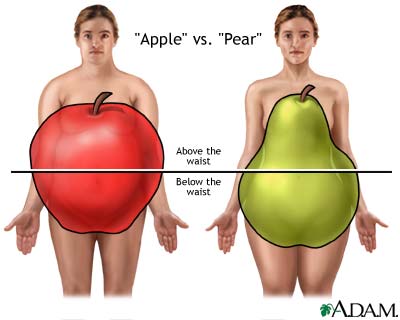| "Ideal weight" does not mean having an ideal
body -- almost everyone has physical features they would like to
change. Rather, ideal weight is a medical term that refers to
how much you should weigh, based on your height, gender, and
age. Doctors use a few different methods to determine whether
you are overweight. The main approaches are measurements of your
body mass index (BMI), your waist circumference, and your
waist-to-hip ratio. A healthy BMI for an
adult generally falls between 18.5 and 25. If your BMI is over
25, you are probably overweight. If it is 30 or higher, you are
considered obese, and 40 or higher, extremely obese.
BMI is not always an accurate way to determine
whether you need to lose weight. Here are some exceptions:
- Body builders:
Since muscle weighs more than fat, people who are unusually
muscular may have a high BMI.
- Elderly: In
the elderly it is often better to have a BMI between 25 and
27, rather than under 25. If you are older than 65, for
example, a slightly higher BMI may help protect you from
osteoporosis.
- Children:
While an alarming number of children are obese, do not use
this BMI calculator for evaluating a child. Talk to your
child's doctor about what an appropriate weight is for his
or her age.
Waist circumference and
waist-to-hip ratio
Your waist circumference indicates how much
fat is collected around your midsection. Doctors aren't sure
why, but fat around your middle (called central obesity) is more
dangerous than fat around other parts of the body, like your
hips. People who have a high waist circumference and a high
waist-to-hip ratio are more at risk for many diseases associated
with being overweight, particularly heart disease and diabetes.

|
Weight gain in the area of the waist and above (apple
type) is more dangerous than weight gained around the
hips and flank area (pear type). Fat cells in the upper
body have different qualities than those found in hips
and thighs. |
- To measure your waist circumference:
Wrap a tape measure around your middle at the level of your
belly button. The risk of heart disease and diabetes
increases if your waist circumference is more than 35 inches
(88 cm) for a woman and more than 40 inches (102 cm) for a
man. You should strive for a waist size less than 31.5
inches if you are a woman and less than 37 inches if you are
a man.
- To measure your waist-to-hip ratio:
Measure your hip circumference at the level of the two bony
prominences felt in the front of your hips. Then, divide
your waist circumference by your hip circumference. Your
waist-to-hip ratio should be below 0.8 for a woman and below
1.0 for a man.
Remember: Some people don't
need to lose weight!
In our culture of thinness, some people strive
to lose weight when they don't need to, or they strive to lose
more weight than they should. Besides the obvious dangers of
anorexia and bulimia, being underweight can cause bone loss, low
blood pressure, and other extremely serious problems.
Before you decide to lose weight, assess
yourself honestly. Do you really need to lose weight? Do others
express surprise or concern that you are considering weight
loss? Do you have expectations for weight loss that go beyond
improving your health? If any of these apply to you, a
professional counselor may be appropriate to help with body
image issues.
|

